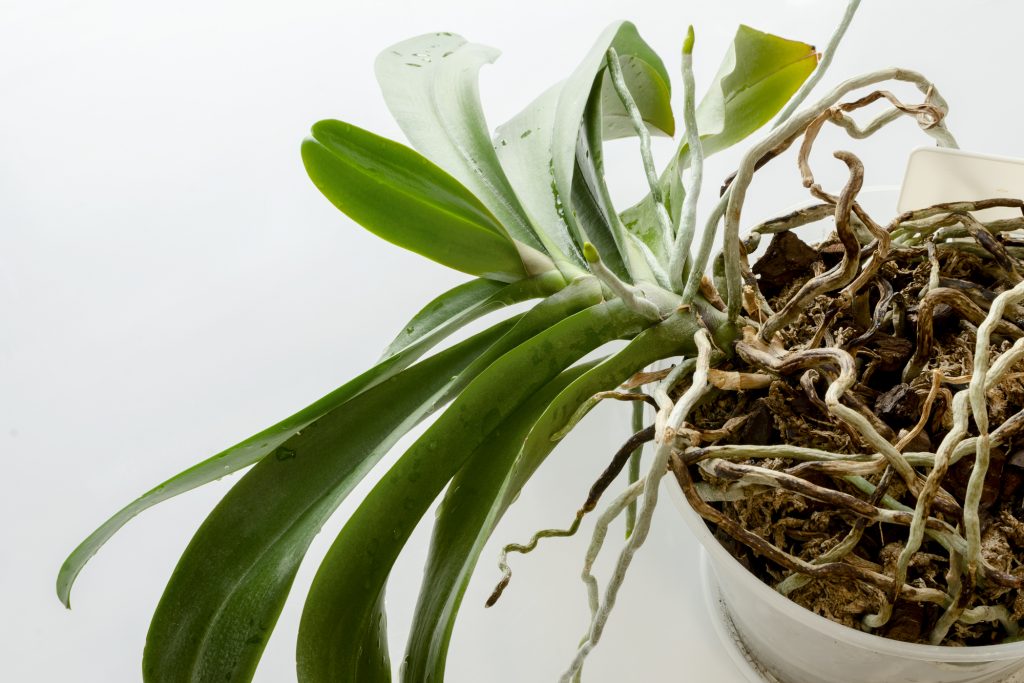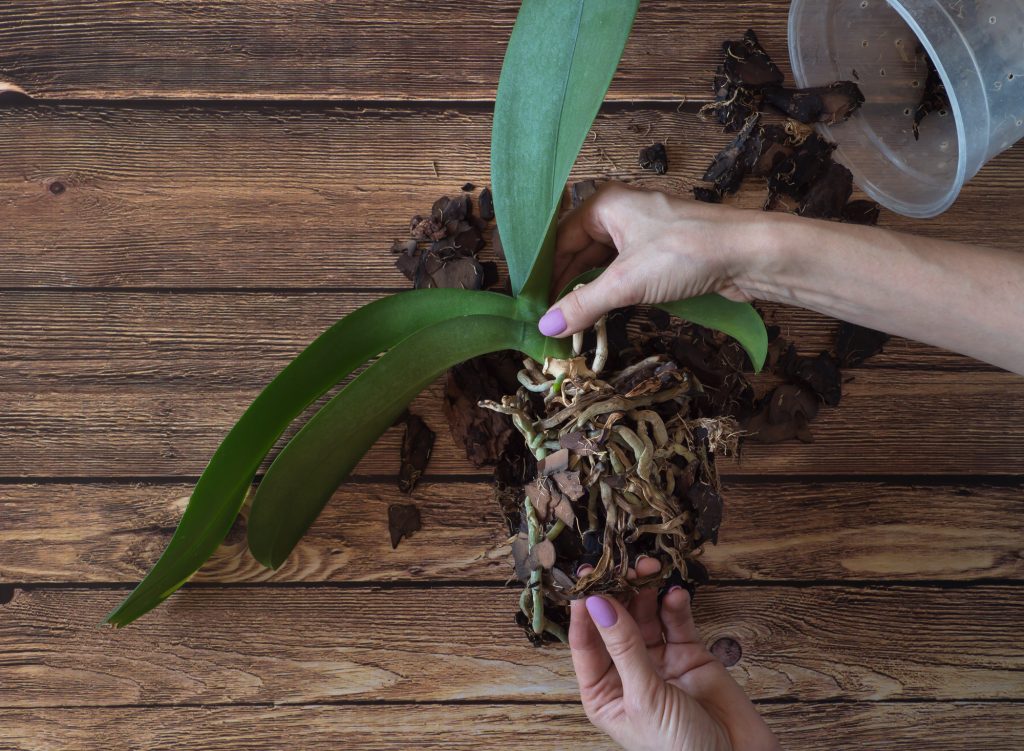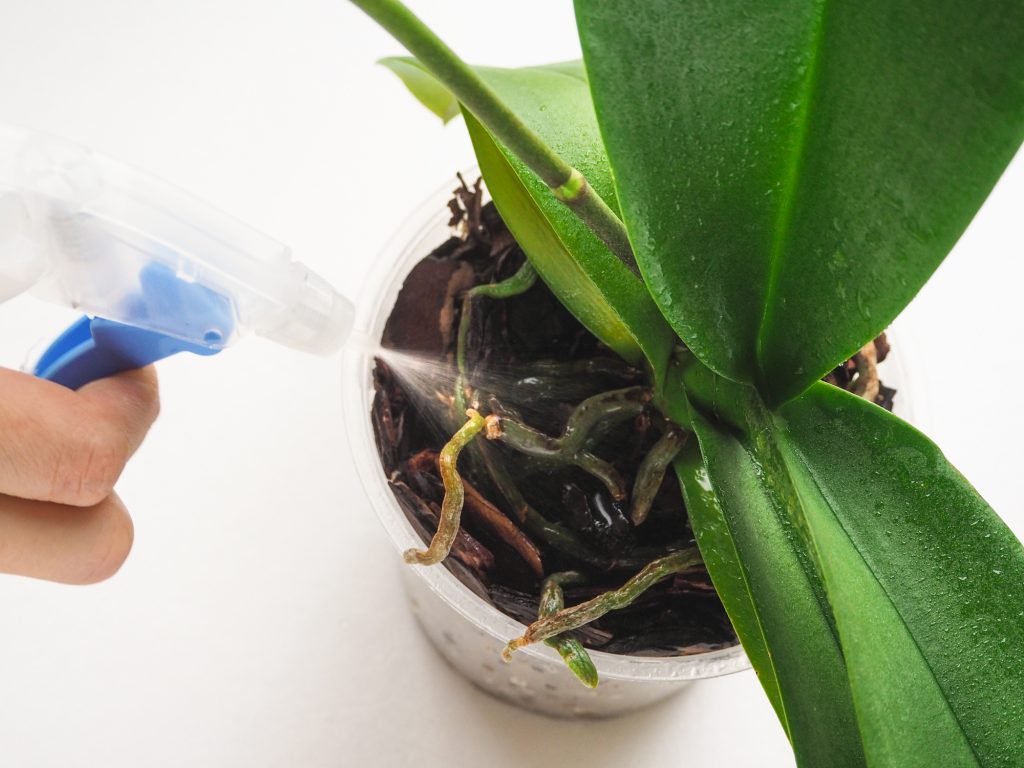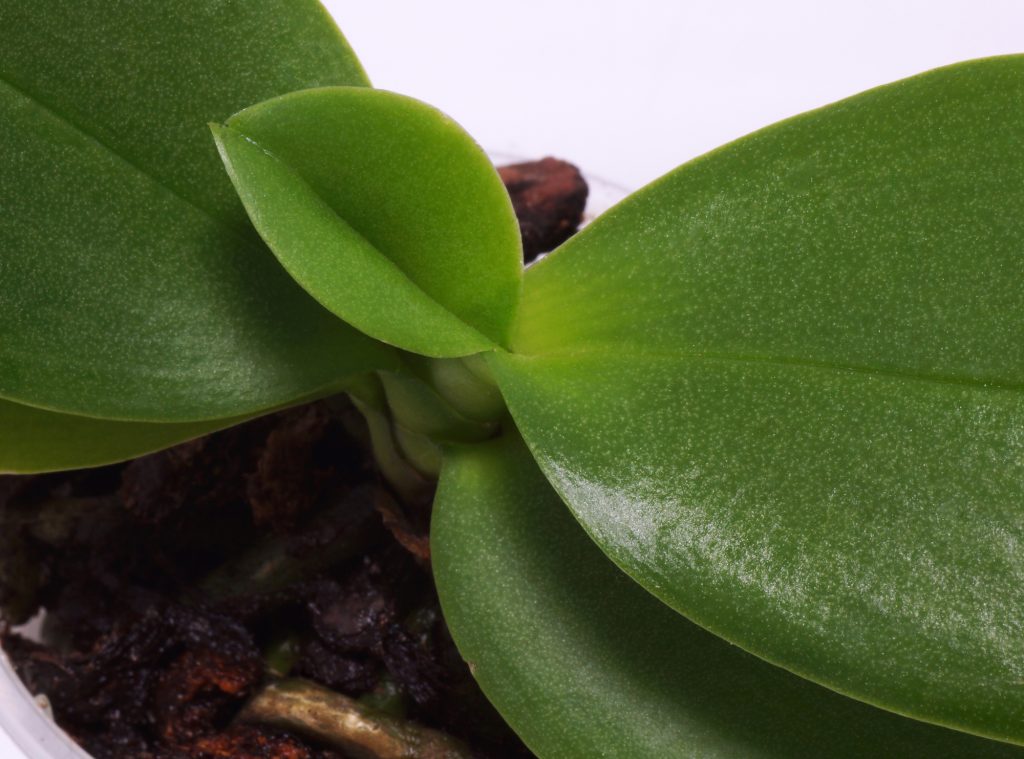The Phalaenopsis orchid is the most common orchid variety sold in North America, and contrary to popular belief, it’s one of the lowest maintenance orchids out there.
Though, this doesn’t mean they’re the easiest plants to care for.
And if you’re here, you’re obviously wondering how to save your dying orchid – and as long as it’s not completely dead, you should be able to revive it in a few simple steps.
It will just take some time and patience.

This post contains affiliate links, which means I may make a small commission if you click through and make a purchase.
Whether you have unhealthy roots or initial signs of stem or crown rot, as long as you catch it early enough you can bring your orchid back to life.
Most orchids can be saved by removing the plant from the pot and media and cutting off rotten roots (sometimes even most of the stem).
Then, spray with hydrogen peroxide if there are signs of fungus, and then repot in a proper orchid pot with new orchid bark (media) and some sphagnum moss.
Follow these steps to bring your dying orchid back to life.
Step 1: Observe the Orchid and Diagnose the Problem
First, take a close look at your orchid to determine its symptoms and what exactly is wrong with it.
You need to be able to tell if your orchid is dying or just dormant.
If you’re a first time orchid parent, there’s a chance that your orchid is just in its resting phase.

For example, if your orchid flowers are dying, that doesn’t mean the plant is gone and that you should throw it out.
Flowers on any orchid will eventually die and fall off, and the stem where they bloomed will go partly brown.
If you have brown stems (flowers spikes) your orchid is not dead!
It then enters into dormancy for a while, but will rebloom again in 6 months to a year in the right conditions.
If it looks generally healthy besides the fact that it has finished blooming, there are some things you can do after the flowers fall off to get it to rebloom.
If the leaves are a nice olive green color and void of wrinkles, you have a healthy orchid.
If the leaves are dark green, this indicates it needs more light and is a simple, early sign that it’s becoming stressed.

Sometimes orchids will lose their bottom leaves naturally.
If a leaf at the bottom is turning yellow and thin, but you have new growth coming from the top, your orchid is okay.
It’s just shedding old leaves to direct energy to the new growth.
The biggest culprit of a dying orchid is overwatering or letting your orchid sit in standing water.
This can manifest through root, stem or crown rot.
And rotting plant matter leads to fungus gnats.
Signs of dying orchids usually include limp leaves that look dehydrated and roots that are yellow, brown, mushy and sometimes black and crispy.

The most common reason for a dying orchid is from root rot, caused by either too much water or the wrong type of potting mixture that doesn’t allow for drainage.
If your orchid is losing all of its leaves or all the leaves are turning yellow, this is a sign of crown rot or stem rot and it may not be able to survive.
However, if it has any aerial roots left, you should be able to salvage it.
Aerial roots are those that are growing above the potting media.
If you have any of these on your plant, you’re in good shape for reviving the orchid, as these roots are less susceptible to rot.

If there are no roots left (or very few), your plant does not have the capacity to soak up the water and the nutrients that it needs.
If your orchid is succumbing to crown rot, the upper part of the stem (lower part of the leaves in the middle) will start turning brown, and black when it’s in its final stages.
Stem rot is also very similar and occurs when water gets trapped between the leaves.
So, if after closer inspection it’s looking a lot worse than just being done with flowering, you’ll have to remove it from its pot and get rid of everything else that’s rotting.
>> You might also like: Trouble with your String of Pearls? Find out why it’s dying and how to save it!
Step 2: Remove the Orchid and Discard Old Media

Gently remove the orchid from its pot. Remember, they like being root bound, so it might feel like it’s tight in there.
Gently squeeze the bottom of the plastic pot to help guide it out.
Remove all of the existing potting media attached to the roots – this is all the bark, chips, moss, mulch and bits of soil.
Be careful during this process as the roots like to wind themselves around the media mix.
Then, lightly rinse off the roots with water to clean them up from debris.
Now you’re left with just the exposed roots, which will be easier to see which ones you need to cut off.

Step 3: Cut off the Dead Roots
At this point, take a pair of sharp shears or a razor blade and sterilize it with rubbing alcohol.

Go ahead and start snipping off each dead or dying root, as much as you can.
Cut off all the roots that are yellow, brown and black, including bits that feel stringy.
The yellow roots will be soft and mushy.

Any roots that are crispy, crunchy or feel hollow – cut those off too. Leave any roots that are green or have green tips meaning new growth.
Depending on the state of your orchid, you may have to cut off the entire stem.
If you have stem rot or your orchid roots have completely rotted away, you can cut off the stem.
Make the cut just below the leaves or just below where it looks like new roots are trying to come in.
If stem rot is occurring, you’ll need to cut away all the parts of the stem that are brown and mushy.

Also cut off any old flower spikes right down to the stem and clean up any dried leaves along the bottom of the stem.
If your orchid had been sitting in its pot and soil for some time and had started to rot, you could go the extra step to spray it with 3% strength hydrogen peroxide.
This will kill off any fungus or pests.
If you’ve determined that the orchid has signs of crown rot, hydrogen peroxide can also be effective at killing off any remaining rot and allow it to regrow.
>> Read Next: Monstera Issues? Diagnose Your Damaged Monstera Leaves & Bring it Back to Life
Step 4: Repot Your Orchid
Choose a clear pot so that you can watch the roots grow and check up on it.
Make sure it has plenty of holes or slots along the side for ventilation and holes on the bottom for drainage.

Fill your pot about two thirds or a little more with your preferred potting mix.
A mix of bark chips and moss is the best.
RePotme has the best orchid mix you can buy on Amazon.
Or you can make your own orchid mix for cheap (here’s the recipe).
Orchids also rebound well when placed in LECA – lightweight expanded clay aggregate. Read more about it here.
Then, place your orchid on top of the bark.
If it has enough healthy roots, you can help stabilize it by covering up the roots with a few more pieces of bark or mulch, but not too deep.
Try to guide the roots down into the pot so that they are pressed up against the sides.
They like being tightly bound and this helps you monitor them.

If you had to cut the stem and there’s not much left of it, you can insert a stake into the soil first, lean the orchid up against it, and secure it with a plastic tie to keep it upright.
You could even use a plastic twist tie (like the ones at the grocery store) to secure the root to the orchid media, almost like a false root.
If you have very little stem left, let it rest on top of the bark chips and don’t cover it or bury it.
Then, use sphagnum moss to cover the top of the bark chips, about one inch thick.
This moss will keep the orchid hydrated by providing a little extra humidity, as well as helping promote root growth.

Using the moss is the key to bringing a dying orchid back to life and is a step that should not be missed, especially when it’s been the victim of root rot.
Keep the moss away from the stem of the orchid to avoid added moisture from which it’s trying to recover from.
Give the pot a quick watering but not too much.

Just enough to moisten the soil through.
You will want to keep the moss hydrated though, so you might have to mist it every day depending on how dry or humid your house is.
Lastly, use root booster to minimize the amount of shock from being replanted.
Step 5: Let the Orchid Come Back to Life
Place your orchid in a warm spot that receives filtered light.
An east facing window is ideal, north facing would also work.
Avoid placing your orchid directly in front of a south or west facing window as this will be too hot for your recovering orchid.
Even a healthy Phalaenopsis won’t be able to survive in that.
Now, all you can do is play the waiting game and monitor your orchid for signs of recovery or deterioration.
As long as you’ve followed all the steps above, it’s unlikely that it will become worse than what it was when you saved it.
It will just take some time to become a thriving Phal again. You will probably be waiting months, if not at least a full year or two.
But it will pay off in the end!

At this point you can continue to fertilize as you normally would.
I like to use the Miracle-Gro plant food, which comes in a mist bottle.
I just give the stem, roots and leaves a quick mist in between waterings.
The spray bottle makes it convenient and helps me avoid over watering. Plus, orchids love a little humidity
With some time and a little luck, your orchid should come back to life and one day rebloom for you!
Review my list of the 13 indoor plant tools I always use and get saving that orchid!
Visit my Houseplant Toolbox for a list of all my favorite supplies & goodies!
Stay Green!
>> Read Next: Indoor Plant Care for Beginners: 15 Fail-proof Tips
>> How to Make Your Own Orchid Mix in 7 Easy Steps
>> Piccola Orchid Care Made Easy: Make Your Mini Orchid Thrive




I hear so many ways to water 1. Ice cubes 1 x week 2. Never use ice cubes , warm water 1 X week mine are going to get your 5 easy steps . Thanks for telling us it can take a year or two. I hope it won’t take that long but will enjoy the venture
Thank you
Barbara
I’ve found that patience is definitely required with orchids! But it does pay off in the end 🙂
My orchid looks pretty sad, leaves are drooping and looks dehydrated, 2 bottom leaves are turning yellow but is still blooming very small flowers. I just recently repotted with orchid chips and a new larger 6” in diameter pot but is still not doing better. What should I do?
Hi Dorothy, perhaps it is still in shock from being re-potted – this can happen and it may need some time to adjust. If the flowers are still blooming this is good news!
One of my orchids has tons of roots above the soil. It is healthy, but it looks ugly. The plant itself isn’t ugly just all the roots sticking out everywhere. Should I replant it and
bury the roots or just leave it along?
These are aerial roots and are a natural occurrence among orchids. If your plant is healthy and thriving, I would leave it alone. They don’t usually like to be disturbed too much. If it’s been a few years since you’ve repotted it, you can do that and try to guide the roots into the substrate.
Thank you so much for the information about the dying Orchard, much appreciated.
You’re very welcome, I hope it helped 🙂
aly
great advice I’m building a greenhouse 9×24 where is the best place to place the orchid bench.
Also where can I get the plastic pots you show?
Doc Bloch
You can find the pots pretty easily on Amazon, there should be a link in the post! As far as the greenhouse are you planting anything else in it? I would say one of the sides so that it doesn’t get unobstructed light.
Thank you for the excellent step by step lessons in saving our beloved plants. You do a huge service for saving these plants from the waste bin. Blessings!!
~Kay, San Jose, CA
Awww thank you so much! They are such beautiful plants and are absolutely worth saving with a little work 🙂
Thsnk you for all the tip you gave to save my orchid. I am going to do all the above to save. First time I have seen orchid in water. Thanks
I’m so glad you found it helpful!
How would you water, how often n how much? there are so many opinions out there?
Hi Tiana, it depends on how much light it’s getting. I water mine about once every 8-10 days. It’s better to underwater than overwater as they are prone to rot very easily.
I wish I had read this sooner! My daughter has bought me an orchid every year for Mother’s Day and when they die off to the point the leaves die, I simply throw them out. I currently have one with no leaves and I am going to try your suggestions and play the waiting game…fingers crossed🤞
I have several leggy orchids. They are years old and the stems have gotten “leggy” although they have aerial roots. Some are leaning sideways. Can they be cut back at the stems to straighten them up. They are healthy plants, just untidy. They are in their original 4” pots. Should they be put in 6” pots, removing any old dead roots or reducing the root ball, perhaps a third of the bottom ?
Jo
Hi Jo, I wouldn’t cut the stems. Try repotting them in your 6 inch pot, and when you repot it you can try to stabilize it a little to keep it upright. You can try to gently guide the aerial roots to help stabilize it as well.
HI I am on this journey now Sounds like I’m not too far off your instructions keep being patient is the key? Thank you this makes me less concerned that I’m doing it correctly. Have never had an orchid this was from a friend and it was on it’s way to the landfill. Do want this plant to survive.
I put my orchid in a bigger glass jar with rocks in the bottom. Then I cover the rocks with water and place in a window with lots of sun. When I started that every orchid I’ve ever had flowers 2-3 times a year.
Great tip! Thank you for sharing
I have been thinking about putting my orchids in a glass jar. However in my past experience I have transplanted orchids before and they died. I bought 2 like 3 to 4 years ago and it’s still alive but hasn’t bloomed flowers for almost 2 years now. How do you really put orchids in the glass jar? What do I need to do? I really don’t want to kill it again!!
Hi Rachel, is there any reason in particular you want transplant it into a glass jar? Orchids prefer to be in a pot that has lots of drainage on the bottom and the sides. If your orchids are still alive and continuing to produce new leaves I would just be patient! I had to wait 4 years to get one of my orchids to re-bloom, and after that it happened once per year. You might want to try moving them to a different spot in your home – they do need a ‘cooler’ period to produce new flowers.
Decided to rehydrate my orchid as leaves were getting soft and limp, do have 2 new leaves forming. Has not flowered in a long time.
When I removed all the dirt in the roots, there are not many healthy roots. I am going to soak the plant to rehydrate, what do I do with the air roots? Do some of them need to be in the water, or are they better left out? Do some of them need to go into the planting meeting when I replant?
Thanks for your help!
Barb
Hi Barb! You can leave the aerial roots alone – leaving some out of the substrate or if some naturally are pointed downward you can gently bury them under the substrate, but I wouldn’t soak them in water 🙂
I have an aerial root growing out between leaves. I am afraid to try to end it to grow in the soil. What should I do.
I would leave it alone, sometimes the aerial roots grow in a way to help stabilize the plant. You can try to guide it into the soil or leave it out, up to you 🙂
I have an orchid that is tall and needs some attention as it seems odd looking. Can i send a picture?
Sure! Can you please send me a photo on instagram? >> https://www.instagram.com/thepottedpixie/
Great tips. My plant was given to me for Mother’s Day. Flowers have fallen and the leaves are green except some are turning black at the connection to the plant. Is this leaf rot? And what should I do?
Unfortunately this sounds like crown rot due to too much water for too long. I would inspect the orchid further. Inspect the roots and the crown (middle stem). If you find mushy parts this is not good. If there’s no mush and all seems healthy underneath, sometimes the darker spots at base of leaves can be a sign of too much light.
My leaves are wrinkled what do I do thank you Alicia
Hi Alicia, this is usually a combination from underwatering (dehydrated) and too much direct sun.
Hi Aly. I have a leaves coming out of the spikes on two of my ORCHIDS! When do I cut it off the spike? I have never seen this before.
Thanks. Sue
Congratulations, your orchid is producing keikis! this means that it will produce new plants as off-shoots that you can then snip off and grow into new orchids. I would wait until they’re a little bigger and start to look like mini orchids before you snip and plant them in their own pot + substrate.
Hello,
I lived in Florida many years and had an orchid hut and many kinds of orchids.
Now I live in Kentucky and only have one type of orchid.
One of my newest orchids quit blooming so I cut off the stems just above a node in hopes of another bloom….To my delight my orchid has produced two Kiki!
This has never happened for me….so I am thrilled but will need help when they grow larger. Just had to share my joy!
Oh my goodness, thank you for sharing! I am so excited for you! I’m actually working on a post right now about how to propagate orchids via the keiki. Stay tuned!
Hi there , I have plenty of of orchids. Some in Orchid mix in a pot and most in a glass jar with volcanic rocks ( they are supposed to retain moisture better?) now and then I need to top up on water and I feed them every 3 weeks , cleaning the glass jars as I go along ( a lot of work) Here is my problem on three of them the leaves have become dehydrated and have tried soaking moss in warm water and close it in a plastic bag for x3 days some longer BUT no differance…what am I doing wrong??
My orchard rotted at the core it still has a lot of roots and a couple green ones at the to but no more leaves and a black core is it done ?
Unfortunately it might be done. It could just take time for the roots to catch up to realize it’s not able to keep itself alive.
Hi, I was given a Palienopsis white (the bend over kind) yesterday, but the leaves are starting to turn yellow and the flowers are folded over and look about to fall off, there are two flowers that are open and looking good. I checked the soil and it seems to me that there is a lot of moss and maybe should have more or mostly bark, can you help?
yes, try replacing some of the moss with more bark. Also, orchids go into shock pretty easily when they’re moved/transported, so this could be a cause as well.
Thanks for the tips on saving my two favorite orchids, which did not bloom this year. I have done what you recommended, but wondering if the stems will ever come back so flowers can appear.
When the flowers fall off and the stem is empty, is it ok to remove the stem? If so, where should I cut it back?
I have 2 orchids. I watered them both using the ice cube method once a week. One is thriving and all the leaves have fallen off the other. I am going to try these steps to see if I can bring it back. I am not sure what I am doing wrong. They sit side by side. Any other tips would be helpful and appreciated.
My orchid has 4 flowers, but the leaves turned yellow and one fell off 🙁
Please help. Advice needed to revive my dying baby orchid plant.